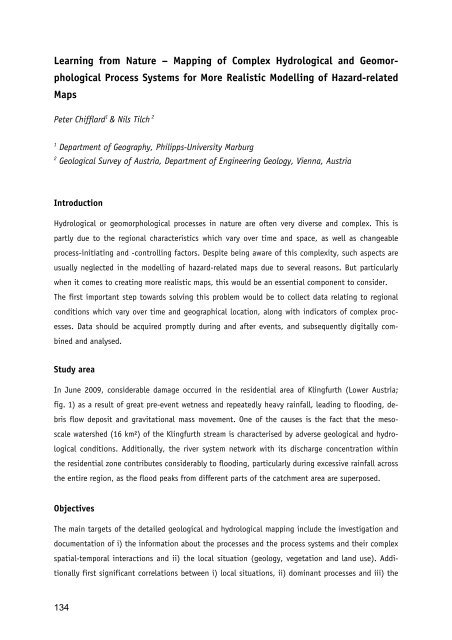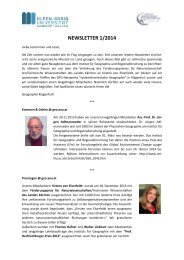Geographica Augustana - Institut für Geographie und ...
Geographica Augustana - Institut für Geographie und ...
Geographica Augustana - Institut für Geographie und ...
Sie wollen auch ein ePaper? Erhöhen Sie die Reichweite Ihrer Titel.
YUMPU macht aus Druck-PDFs automatisch weboptimierte ePaper, die Google liebt.
Learning from Nature – Mapping of Complex Hydrological and GeomorphologicalProcess Systems for More Realistic Modelling of Hazard-relatedMapsPeter Chifflard 1 & Nils Tilch 21 Department of Geography, Philipps-University Marburg2Geological Survey of Austria, Department of Engineering Geology, Vienna, AustriaIntroductionHydrological or geomorphological processes in nature are often very diverse and complex. This ispartly due to the regional characteristics which vary over time and space, as well as changeableprocess-initiating and -controlling factors. Despite being aware of this complexity, such aspects areusually neglected in the modelling of hazard-related maps due to several reasons. But particularlywhen it comes to creating more realistic maps, this would be an essential component to consider.The first important step towards solving this problem would be to collect data relating to regionalconditions which vary over time and geographical location, along with indicators of complex processes.Data should be acquired promptly during and after events, and subsequently digitally combinedand analysed.Study areaIn June 2009, considerable damage occurred in the residential area of Klingfurth (Lower Austria;fig. 1) as a result of great pre-event wetness and repeatedly heavy rainfall, leading to flooding, debrisflow deposit and gravitational mass movement. One of the causes is the fact that the mesoscalewatershed (16 km²) of the Klingfurth stream is characterised by adverse geological and hydrologicalconditions. Additionally, the river system network with its discharge concentration withinthe residential zone contributes considerably to flooding, particularly during excessive rainfall acrossthe entire region, as the flood peaks from different parts of the catchment area are superposed.ObjectivesThe main targets of the detailed geological and hydrological mapping include the investigation anddocumentation of i) the information about the processes and the process systems and their complexspatial-temporal interactions and ii) the local situation (geology, vegetation and land use). Additionallyfirst significant correlations between i) local situations, ii) dominant processes and iii) the134



